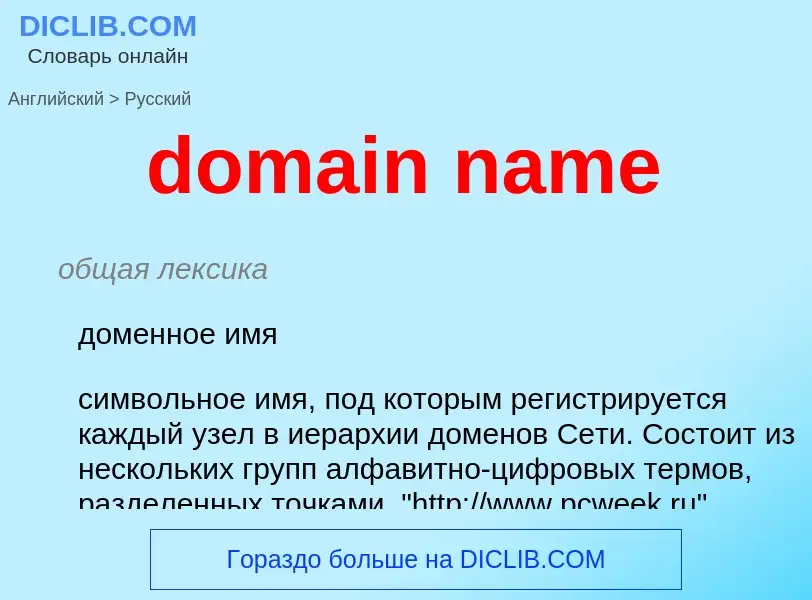Перевод и анализ слов искусственным интеллектом ChatGPT
На этой странице Вы можете получить подробный анализ слова или словосочетания, произведенный с помощью лучшей на сегодняшний день технологии искусственного интеллекта:
- как употребляется слово
- частота употребления
- используется оно чаще в устной или письменной речи
- варианты перевода слова
- примеры употребления (несколько фраз с переводом)
- этимология
domain name - перевод на Английский
общая лексика
доменное имя
символьное имя, под которым регистрируется каждый узел в иерархии доменов Сети. Состоит из нескольких групп алфавитно-цифровых термов, разделенных точками, "http://www.pcweek.ru". Самый правый терм в имени домена определяет тип организации или страну. Синтаксис записи доменных имён описан в RFC 1035. В декабре 2000 г. ICANN принято ещё семь типов доменов верхнего уровня (.arrow, .biz, .info, .museum, .coop, .name, .pro)
Смотрите также
общая лексика
сервер [преобразования] имён
входящий в систему DSN компьютер (обычно сервер с ОС Unix), осуществляющий во взаимодействии с другими серверами имён преобразование имён хост-компьютеров в их IP-адреса. На сервере имён имеется база данных системы DSN, содержащая указатели на другие серверы DSN
синоним
Определение
1) Принудительное безвозмездное - конфискация - или оплачиваемое - реквизиция - изъятие чего-л., производимое государственными органами.
2) Лишение одним классом или одним из слоев класса собственности и прежнего социального положения другого класса или другого слоя того же класса.
3) Любое принудительное отчуждение чего-л.
Википедия
In the Internet, a domain name is a string that identifies a realm of administrative autonomy, authority or control. Domain names are often used to identify services provided through the Internet, such as websites, email services and more. As of 2017, 330.6 million domain names had been registered. Domain names are used in various networking contexts and for application-specific naming and addressing purposes. In general, a domain name identifies a network domain or an Internet Protocol (IP) resource, such as a personal computer used to access the Internet, or a server computer.
Domain names are formed by the rules and procedures of the Domain Name System (DNS). Any name registered in the DNS is a domain name. Domain names are organized in subordinate levels (subdomains) of the DNS root domain, which is nameless. The first-level set of domain names are the top-level domains (TLDs), including the generic top-level domains (gTLDs), such as the prominent domains com, info, net, edu, and org, and the country code top-level domains (ccTLDs). Below these top-level domains in the DNS hierarchy are the second-level and third-level domain names that are typically open for reservation by end-users who wish to connect local area networks to the Internet, create other publicly accessible Internet resources or run web sites.
The registration of a second- or third-level domain name is usually administered by a domain name registrar who sell its services to the public.
A fully qualified domain name (FQDN) is a domain name that is completely specified with all labels in the hierarchy of the DNS, having no parts omitted. Traditionally a FQDN ends in a dot (.) to denote the top of the DNS tree. Labels in the Domain Name System are case-insensitive, and may therefore be written in any desired capitalization method, but most commonly domain names are written in lowercase in technical contexts.

![absolutepoker.com]] absolutepoker.com]]](https://commons.wikimedia.org/wiki/Special:FilePath/Absolutepoker.png?width=200)

![libertyreserve.com]] libertyreserve.com]]](https://commons.wikimedia.org/wiki/Special:FilePath/Liberty Reserve seizure notice.png?width=200)
